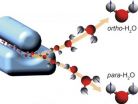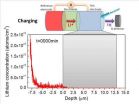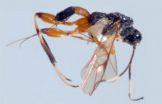(Press-News.org) CAMBRIDGE, Mass-- Around the world, there is more salty groundwater than fresh, drinkable groundwater. For example, 60 percent of India is underlain by salty water — and much of that area is not served by an electric grid that could run conventional reverse-osmosis desalination plants.
Now an analysis by MIT researchers shows that a different desalination technology called electrodialysis, powered by solar panels, could provide enough clean, palatable drinking water to supply the needs of a typical village. The study, by MIT graduate student Natasha Wright and Amos Winter, the Robert N. Noyce Career Development Assistant Professor of Mechanical Engineering, appears in the journal Desalination.
Winter explains that finding optimal solutions to problems such as saline groundwater involves "detective work to understand the full set of constraints imposed by the market." After weeks of field research in India, and reviews of various established technologies, he says, "when we put all these pieces of the puzzle together, it pointed very strongly to electrodialysis" — which is not what is commonly used in developing nations.
The factors that point to the choice of electrodialysis in India include both relatively low levels of salinity — ranging from 500 to 3,000 milligrams per liter, compared with seawater at about 35,000 mg/L — as well as the region's lack of electrical power. (For on-grid locations, the team found, reverse-osmosis plants can be economically viable.)
Such moderately salty water is not directly toxic, but it can have long-term effects on health, and its unpleasant taste can cause people to turn to other, dirtier water sources. "It's a big issue in the water-supply community," Winter says.
Expanding access to safe water
By pairing village-scale electrodialysis systems — a bit smaller than the industrial-scale units typically produced today — with a simple set of solar panels and a battery system to store the produced energy, Wright and Winter concluded, an economically viable and culturally acceptable system could supply enough water to meet the needs of a village of 2,000 to 5,000 people. They estimate that deployment of such systems would double the area of India in which groundwater — which is inherently safer, in terms of pathogen loads, than surface water — could provide acceptable drinking water.
While many homes in India currently use individual, home-based filtration systems to treat their water, Wright says after consulting with nongovernmental organizations that work in the area, she and Winter concluded that village-scale systems would be more effective — both because fewer people would be left out of access to clean water, and because home-based systems are much harder to monitor to ensure effective water treatment.
Most organizations working to improve clean-water access focus their attention on controlling known pathogens and toxins such as arsenic, Wright says. But her analysis showed the importance of "what the water tastes like, smells like, and looks like." Even if the water is technically safe to drink, that doesn't solve the problem if people refuse to drink it because of the unpleasant salty taste, she says.
At the salinity levels seen in India's groundwater, the researchers found, an electrodialysis system can provide fresh water for about half the energy required by a reverse-osmosis system. That means the solar panels and battery storage system can be half as big, more than offsetting the higher initial cost of the electrodialysis system itself.
How it works
Electrodialysis works by passing a stream of water between two electrodes with opposite charges. Because the salt dissolved in water consists of positive and negative ions, the electrodes pull the ions out of the water, Winter says, leaving fresher water at the center of the flow. A series of membranes separate the freshwater stream from increasingly salty ones.
Both electrodialysis and reverse osmosis require the use of membranes, but those in an electrodialysis system are exposed to lower pressures and can be cleared of salt buildup simply by reversing the electrical polarity. That means the expensive membranes should last much longer and require less maintenance, Winter says. In addition, electrodialysis systems recover a much higher percentage of the water — more than 90 percent, compared with about 40 to 60 percent from reverse-osmosis systems, a big advantage in areas where water is scarce.
Having carried out this analysis, Wright and Winter plan to put together a working prototype for field evaluations in India in January. While this approach was initially conceived for village-scale, self-contained systems, Winter says the same technology could also be useful for applications such as disaster relief, and for military use in remote locations.
INFORMATION:
The research was funded by Jain Irrigation Systems, an Indian company that builds and installs solar-power systems, and sponsored by the Tata Center for Technology and Design at MIT.
Written by David Chandler, MIT News Office
Sun-powered desalination for villages in India
Off-grid communities with salty groundwater could get potable water through a proposed solar technique
2014-09-08
ELSE PRESS RELEASES FROM THIS DATE:
New mechanism in gene regulation revealed
2014-09-08
The information encoded in our genes is translated into proteins, which ultimately mediate biological functions in an organism. Messenger RNA (mRNA) plays an important role, as it is the molecular template used for translation. Scientists from the Helmholtz Zentrum Muenchen and the Technische Universität Muenchen, in collaboration with international colleagues, have now unraveled a molecular mechanism of mRNA recognition, which is essential for understanding differential gene regulation in male and female organisms. The results are published in the renowned scientific journal ...
Researchers part water
2014-09-08
Using an "electric prism", scientists have found a new way of separating water molecules that differ only in their nuclear spin states and, under normal conditions, do not part ways. Since water is such a fundamental molecule in the universe, the recent study may impact a multitude of research areas ranging from biology to astrophysics. The research team from the Center for Free-Electron Laser Science (CFEL) – a collaboration of DESY, the Max Planck Society and Universität Hamburg – reported its results in the journal Angewandte Chemie International Edition.
At first ...
Simeprevir in hepatitis C: Added benefit for certain patients
2014-09-08
The drug simeprevir (trade name: Olysio) has been available since May 2014 for the treatment of adult patients with chronic hepatitis C infection. In an early benefit assessment pursuant to the Act on the Reform of the Market for Medicinal Products (AMNOG), the German Institute for Quality and Efficiency in Health Care (IQWiG) examined whether this new drug offers an added benefit over the appropriate comparator therapy.
The drug manufacturer dossier provided indications and hints of an added benefit of simeprevir when the patients infected with hepatitis C virus (HCV) ...
Plant diversity in China vital for global food security
2014-09-08
With climate change threatening global food supplies, new research claims the rich flora of China could be crucial to underpin food security in the future.
A team from the University of Birmingham and partners in China have identified 871 wild plant species native to China that have the potential to adapt and maintain 28 globally important crops, including rice, wheat, soybean, sorghum, banana, apple, citrus fruits, grape, stone fruits and millet. 42% of these wild plant species, known as crop wild relatives (CWR) occur nowhere else in the world.
CWR are wild plant ...
Plant insights could help develop crops for changing climates
2014-09-08
Crops that thrive in changing climates could be developed more easily, thanks to fresh insights into plant growth.
A new computer model that shows how plants grow under varying conditions could help scientists develop varieties likely to grow well in future.
Scientists built the model to investigate how variations in light, day length, temperature and carbon dioxide in the atmosphere influence the biological pathways that control growth and flowering in plants.
They found differences in the way some plant varieties distribute nutrients under varying conditions, ...
First-ever look inside a working lithium-ion battery
2014-09-08
VIDEO:
Using a neutron beam, chemists and engineers at The Ohio State University were able to track the flow of lithium atoms into and out of an electrode in real time...
Click here for more information.
COLUMBUS, Ohio—For the first time, researchers have been able to open a kind of window into the inner workings of a lithium-ion battery.
Using a neutron beam, chemists and engineers at The Ohio State University were able to track the flow of lithium atoms into and out ...
Targeted immune booster removes toxic proteins in mouse model of Alzheimer's disease
2014-09-08
Alzheimer's disease experts at NYU Langone Medical Center and elsewhere are reporting success in specifically harnessing a mouse's immune system to attack and remove the buildup of toxic proteins in the brain that are markers of the deadly neurodegenerative disease.
Reporting on their experiments in the journal Acta Neuropathologica Communications online Sept. 3, the researchers say the work advances the development of more effective clinical treatments for Alzheimer's because their immune booster reduced both amyloid beta plaques and tau tangles. Previous immunomodulatory ...
Nearly half of older adults have care needs
2014-09-08
Nearly half of older adults – 18 million people—have difficulty or get help with daily activities, according to a new study.
Researchers from the University of Michigan and the Urban Institute analyzed data from a national sample of older adults drawn from Medicare enrollment files. In all, 8,245 people were included in the 2011 the National Health and Aging Trends Study. The analysis was published in the current (September 2014) issue of the Milbank Memorial Quarterly.
"Although 51 percent reported having no difficulty in the previous month, 29 percent reported receiving ...
The future of our crops is at risk in conflict zones, say Birmingham scientists
2014-09-08
Wild species related to our crops which are crucial as potential future food resources have been identified by University of Birmingham scientists, however, a significant proportion are found in conflict zones in the Middle East, where their conservation is increasingly comprised.
The scientists have identified 'hotspots' around the globe where crop wild relatives (CWR) – species closely related to our crops which are needed for future crop variety development – could be conserved in the wild in order to secure future global food resources.
The hotspot where CWR ...
New parasitoid wasp species found in China
2014-09-08
For the first time, wasps in the genus Spasskia (family: Braconidae) have been found in China, according to an article in the open-access Journal of Insect Science. In addition, a species in that genus which is totally new to science was also discovered.
The new species, Spasskia brevicarinata, is very small — male and female adults are less than one centimeter long. It is similar to a previously described species called Spasskia indica, but the ridges on some of its body segments are different. In fact, the species epithet brevicarinata reflects a short ridge on its ...
LAST 30 PRESS RELEASES:
A new way to map how cells choose their fate
Numbers in our sights affect how we perceive space
SIMJ announces global collaborative book project in commemoration of its 75th anniversary
Air pollution exposure and birth weight
Obstructive sleep apnea risk and mental health conditions among older adults
How talking slows eye movements behind the wheel
The Ceramic Society of Japan’s Oxoate Ceramics Research Association launches new international book project
Heart-brain connection: international study reveals the role of the vagus nerve in keeping the heart young
Researchers identify Rb1 as a predictive biomarker for a new therapeutic strategy in some breast cancers
Survey reveals ethical gaps slowing AI adoption in pediatric surgery
Stimulant ADHD medications work differently than thought
AI overestimates how smart people are, according to HSE economists
HSE researchers create genome-wide map of quadruplexes
Scientists boost cell "powerhouses" to burn more calories
Automatic label checking: The missing step in making reliable medical AI
Low daily alcohol intake linked to 50% heightened mouth cancer risk in India
American Meteorological Society announces Rick Spinrad as 2026 President-Elect
Biomass-based carbon capture spotlighted in newly released global climate webinar recording
Illuminating invisible nano pollutants: advanced bioimaging tracks the full journey of emerging nanoscale contaminants in living systems
How does age affect recovery from spinal cord injury?
Novel AI tool offers prognosis for patients with head and neck cancer
Fathers’ microplastic exposure tied to their children’s metabolic problems
Research validates laboratory model for studying high-grade serous ovarian cancer
SIR 2026 delivers transformative breakthroughs in minimally invasive medicine to improve patient care
Stem Cell Reports most downloaded papers of 2025 highlight the breadth and impact of stem cell research
Oxford-led study estimates NHS spends around 3% of its primary and secondary care budget on the health impacts of heat and cold in England
A researcher’s long quest leads to a smart composite breakthrough
Urban wild bees act as “microbial sensors” of city health.
New study finds where you live affects recovery after a hip fracture
Forecasting the impact of fully automated vehicle adoption on US road traffic injuries
[Press-News.org] Sun-powered desalination for villages in IndiaOff-grid communities with salty groundwater could get potable water through a proposed solar technique


